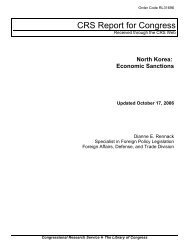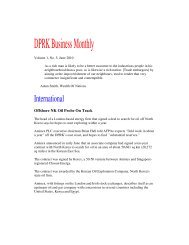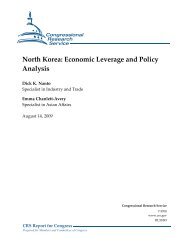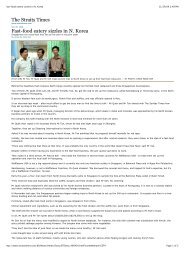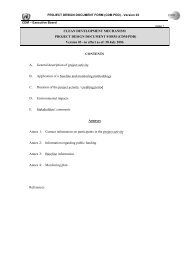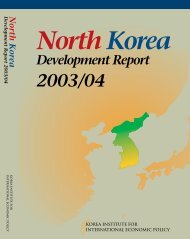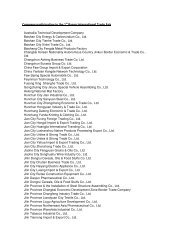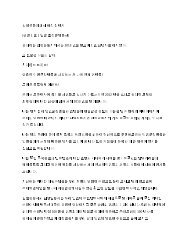North Korean Policy Elites - Defense Technical Information Center
North Korean Policy Elites - Defense Technical Information Center
North Korean Policy Elites - Defense Technical Information Center
Create successful ePaper yourself
Turn your PDF publications into a flip-book with our unique Google optimized e-Paper software.
Gause, Kim Jong-il, through his personal secretary Kim Kang-chol, has a “dedicated personal<br />
apparatus to assist him in gathering information about the outside world. This apparatus is not<br />
consolidated, but spread throughout the regime, with tentacles that reach into a variety of party,<br />
state, and military institutions.” “In addition to reports prepared by their staffs, some <strong>North</strong><br />
<strong>Korean</strong> leaders have developed some dedicated channels for additional information. This is done<br />
through personal contacts and alliances formed with one or another bureaucracy. Leaders also<br />
seek to reach accommodations with various counterintelligence organizations for both reasons of<br />
political survival and to protect private ventures, which, if discovered, could lead to allegations<br />
of corruption.” Gause identifies the primary sources of external information as MOFA<br />
intelligence from the embassies, and overseas “correspondents.”<br />
Hassig surveys the content of <strong>North</strong> Korea’s domestic print and electronic media, which<br />
are available to all the elite. He also lists the various foreign radio sources that broadcast into the<br />
country, such as Radio Free Asia. Although the dials of <strong>North</strong> <strong>Korean</strong> radios are supposed to be<br />
fixed to the government station frequency, many <strong>North</strong> <strong>Korean</strong>s unfix these dials, putting<br />
themselves at risk of arrest; higher-level cadres apparently listen to such radios without much<br />
danger of being caught or punished. Other than official communication channels, the only secure<br />
way news can be disseminated within the country is by face-to-face contact, and according to<br />
defectors, such communication must be conducted with some discretion.<br />
Hassig’s major emphasis is on how the elite could acquire news of U.S. military<br />
initiatives. He conducts an informal survey that demonstrates the impressive breadth of<br />
knowledge on this subject that is carried by <strong>North</strong> Korea’s two major domestic news outlets:<br />
Nodong Sinmun and the <strong>Korean</strong> Central Broadcasting Station. He concludes that if the <strong>North</strong><br />
<strong>Korean</strong> elite pay attention to these channels, they are better informed about U.S. military<br />
initiatives in Asia than are most well-educated Americans.<br />
D. HOW IS FOREIGN INFORMATION PERCEIVED?<br />
Whatever their access to foreign information, the <strong>North</strong> <strong>Korean</strong> elite will surely perceive<br />
such information in their own unique way, and draw their own conclusions. For example, all<br />
<strong>North</strong> <strong>Korean</strong>s heard about the October 2000 visit to Pyongyang of Secretary of State Albright,<br />
but what did it mean to them? Was it seen as a gesture of peace or as a visit by a representative<br />
of a declining power to pay homage to the memory of Great Leader Kim Il-sung (whose tomb<br />
she visited)?<br />
The interpretation of information is likely to be shaped in several ways. Bermudez speaks<br />
of a four-layered “darkly colored lens” filtering information flowing to Kim Jong-il and the top<br />
elites: “historical world view, political indoctrination, hatred for the U.S., and authoritarian<br />
VI-6



